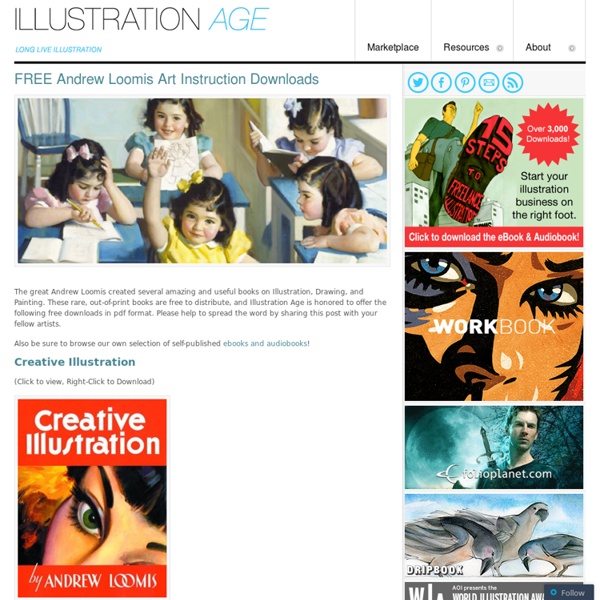Drawing Portraits
Our lesson on drawing portraits is an illustrated step by step tutorial that will teach you the skills and techniques you need to help you draw a convincing pencil portrait. Our section on the Proportions of the Head helps you to measure the size, calculate the shape and position the features of a face in your drawings. If you follow these basic proportions you should notice an improvement in the accuracy of your portraits. These measurements are something that you need to understand before you start any portrait.
Manuali Disegno
How I Teach Game Design. (Lesson 1: The Game Design Process) | being playful
how and why to iterate + a game modification exerciseIterative design In the syllabus I shared in my last How I Teach Game Design post, graded assignments are given out on one week, and then one or two or three weeks later, they are due. So what happens in-between, during the actual work time? The answer is: the iterative design process. Iterative design means a process focused on playtesting. You produce a playable prototype of a game as quickly as possible, then playtest the prototype, and you decide how to evolve the game based on the experience of the playtest. Of course, this caricature is absurd: no game designer I know has ever released a game without playtesting it. What’s the big deal about iteration? The process of iteration consists of these steps: design a prototypeplaytest your prototypeanalyze what happened (then it’s back to step 1 – modifying your game to create a new prototype) Principles of iteration Below are a few ideas to keep in mind about the iterative process.
Human Anatomy Fundamentals: Basics of The Face
Having thoroughly explored the human body, it is time to start looking more closely at its details, starting with the face. The very first thing the eye looks for, in any setting, is the human face, and this applies also to art: a viewer will first look at the face of your character. Mastering the face, particularly the drawing of lively expressive faces, is therefore well worth the effort. In this tutorial we're learning the basics of the face – proportions, features and foreshortening, and we'll go into the details of facial variations in our next session. The skull is a slightly flattened sphere, to which the jaw is appended so that, seen face-on, it has the shape of an egg, pointy side down. Two perpendicular midlines cut the egg into four quarters. Mark the middle points of the left and right halves: The eyes sit on the midline, on these middle points.Divide the lower half in five: The bottom of the nose is two points down from the midline. On the skull: On the face:
Andrew Loomis – Drawing the Head and Hands
Andrew Loomis – Drawing the Head and Hands Pagg. 43-44. La testa standard Buongiorno a tutti e buon inizio di primavera! Pagg. 41-42. Ciao a tutti! Pagg. 37-40. Buongiorno a tutti! Pagg. 34-36. Ciao a tutti! Pagg. 31-33. Ciao a tutti! Pagg. 28-30. Ciao a tutti! Pagg. 25-27. Ciao a tutti! Pagg. 22-24. Oggi riprendiamo Drawing the Head and Hands! Pagg. 17-21. Dedico questo capitolo ad Adriano, che ha sostenuto questo progetto con una donazione. Pagg. 1-16. Come promesso, oggi iniziamo un altro manuale!
manual.pdf
How to Draw Facial Expressions to Show Emotion
In this Quick Tip I will be showing some useful guidelines you can follow to create the base of a head with facial features, following that up with quick tips on how to shape the facial features to create an expression/show emotion! We will start by creating a base shape of the head before focusing on the expressions. Start by drawing out a simple head shape, an oval for the skull, two ears, a neck and the start of the shoulder. Once you've got a shape that pleases you, we will start placing in the grid that will help us place the facial features. Now draw a vertical line that separates the face in half and make sure either size are about the same width. The nose is the one that will help us with all the other facial features. With the temples created, you'll also know where the outer corners of your eyes are located; so, with the inner and outer corners determined, you can shape out the eyes. Here you want to use the smile expression for a base.
Fumetti
Gwent Cards in Printable A4 Sheets
How to Draw the Head From Any Angle
The Basic Forms To draw the head from any angle you must first understand its basic structure. Look past all the distracting details and visualize the underlying forms. The head deconstructed into its basic forms, is a sphere as the cranium and a block as the jaw and cheek bones. A Sphere as the Cranium The sides of the head are flat, so we can slice off a piece from both sides of the ball. A Block as the Jaw and Cheek Bones Attach the shape of the jaw. Constructing From Any Angle Step 1 – Determine the angle of the ball The angle of the head is established at the very beginning of the drawing with the ball. X Axis - The up and down tilt is established by the angles of the horizontal and vertical lines in the oval. Y Axis - The direction the head is turning (left or right) is established by the width of the oval. Z Axis - The twist is established by the angle of the center line, the angle of the oval and the placement of the oval on the ball. Step 2 – Find the thirds Step 3 – Add the jaw



